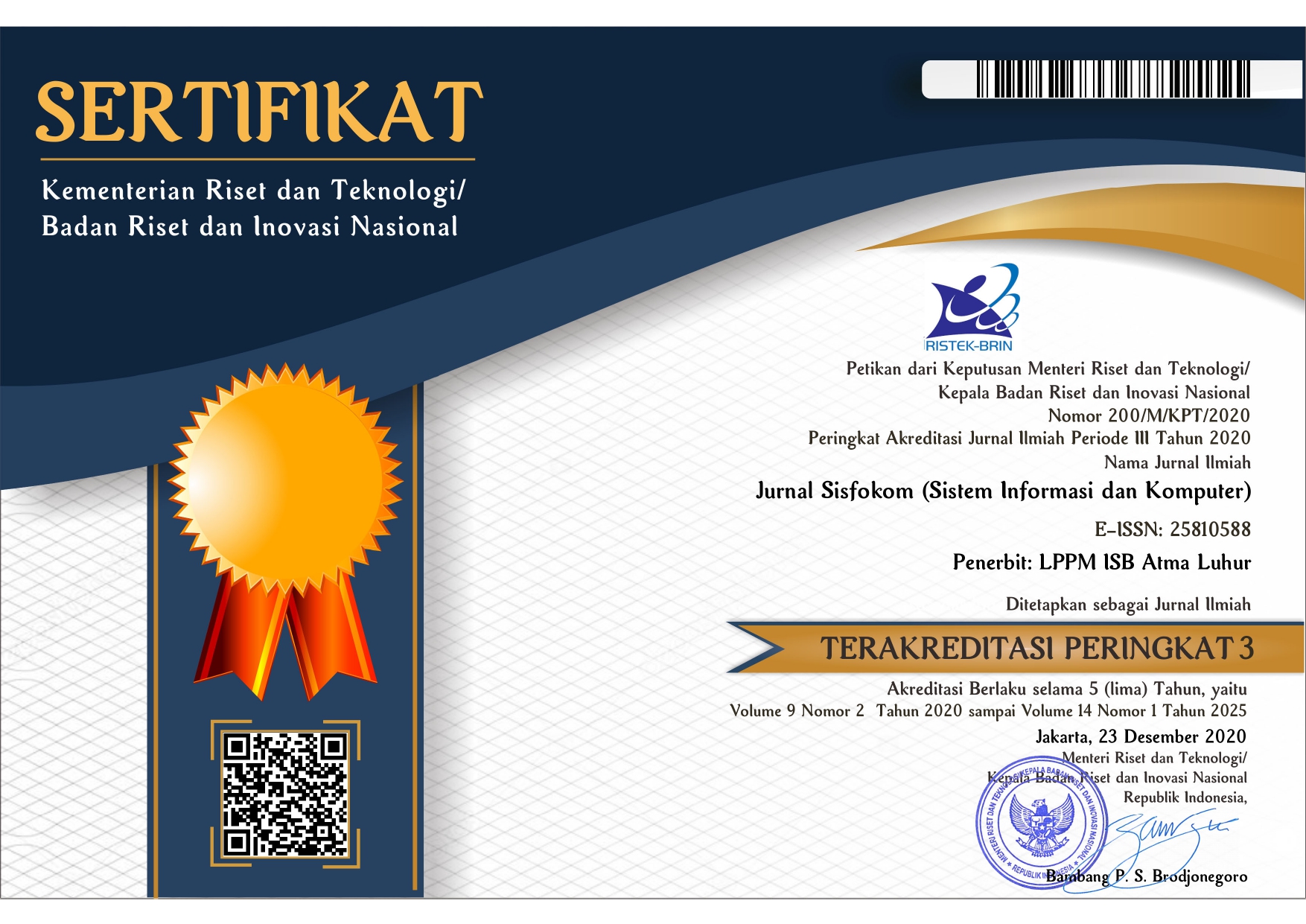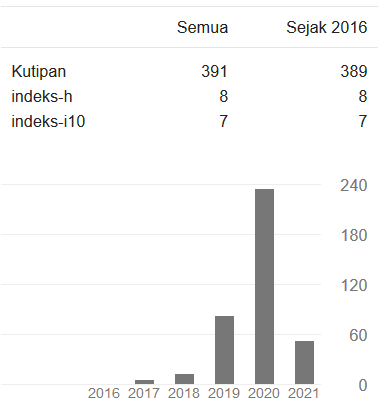Heart Chamber Segmentation in Cardiomegaly Conditions Using the CNN Method with U-Net Architecture
DOI:
https://doi.org/10.32736/sisfokom.v12i3.1976Keywords:
Segmentation, Cardiomegaly, Convolutional Neural Network, U-Net, Deep LearningAbstract
Cardiomegaly is a disease in which sufferers show no symptoms and have symptoms such as shortness of breath, abnormal heartbeat and edema. Cardiomegaly will cause the sufferer's heart to pump harder than usual. Early diagnosis of cardiomegaly can help make decisions about whether the heart is abnormal or normal. In addition, due to the problem that manual examination takes time and requires human interpretation and experience, tools are needed to automatically develop and identify normal and abnormal hearts. Therefore, this study proposes cardiac chamber segmentation using 2D (two-dimensional) ultrasound convolutional neural networks for rapid cardiomegaly screening in clinical applications based on heart ultrasound examination. The proposed approach uses a CNN with a U-Net architecture model with abnormal and normal heart data. The research results obtained used the pixel matrix evaluation Avg_accuracy of 99.50%, Val_accuracy of 97.98% and Mean_IoU of 90.01%.References
Semsarian, C.; Ingles, J.; Maron, M.S.; Maron, B.J. New Perspectives on the Prevalence of Hypertrophic Cardiomyopathy. J. Am. Coll. Cardiol. 2015, 65, 1249–1254.
Badan Penelitian dan Pengembangan Kesehatan Kementerian Kesehatan RI. 2019. Riset Kesehatan Dasar
Roseno, M. T., & Syaputra, H. (2022). Classification of Fetal Heart Based on Images Augmentation Using Convolutional Neural Network Method. Journal of Information Systems and Informatics, 4(2), 252–265. https://doi.org/10.51519/journalisi.v4i2.247.
Chen, L.-C.; Papandreou, G.; Kokkinos, I.; Murphy, K.; Yuille, A.L. DeepLab: Semantic Image Segmentation with Deep Convolutional Nets, Atrous Convolution, and Fully Connected CRFs. arXiv 2017, arXiv:1606.00915.
D. Ravi et al., “Deep learning for health informatics,” IEEE J. Biomed. Heal. informatics, vol. 21, no. 1, pp. 4–21, 2017.
Hatamizadeh, A.; Terzopoulos, D.; Myronenko, A. Edge-Gated CNNs for Volumetric Semantic Segmentation of Medical Images. arXiv 2020, arXiv:2002.04207.
H.-C. Shin, et al., “Deep Convolutional Neural Networks for Computer-Aided Detection: CNN Architectures, Dataset Characteristics and Transfer Learning.,” IEEE Trans. Med. Imaging, vol. 35, no. 5, pp. 1285–1298, May 2016, doi: 10.1109/TMI.2016.2528162.
Wu, J. X., Pai, C. C., Kan, C. D., Chen, P. Y., Chen, W. L., & Lin, C. H. (2022). Chest X-Ray Image Analysis with Combining 2D and 1D Convolutional Neural Network Based Classifier for Rapid Cardiomegaly Screening. IEEE Access, 10, 47824–47836. https://doi.org/10.1109/ACCESS.2022.3171811
Havaei, M.; Davy, A.; Warde-Farley, D.; Biard, A.; Courville, A.; Bengio, Y.; Pal, C.; Jodoin, P.-M.; Larochelle, H. Brain Tumor Segmentation with Deep Neural Networks. Med. Image Anal. 2017, 35, 18–31.
J. Dai, K. He, and J. Sun, “Convolutional feature masking for joint object and stuff segmentation,” Proc. IEEE Comput. Soc. Conf. Comput. Vis. Pattern Recognit., vol. 07-12-June, pp. 3992–4000, 2015, doi: 10.1109/CVPR.2015.7299025.
T. Wiatowski and H. Bölcskei, “A mathematical theory of deep convolutional neural networks for feature extraction,” IEEE Trans. Inf. Theory, vol. 64, no. 3, pp. 1845–1866, 2018.
S. Rueda et al., “Evaluation and comparison of current fetal ultrasound image segmentation methods for biometric measurements: A grand challenge,” IEEE Trans. Med. Imaging, vol. 33, no. 4, pp. 797–813, 2014, doi: 10.1109/TMI.2013.2276943.
G. Padmavathi, P. Subashini, and A. Sumi, “Empirical Evaluation of Suitable Segmentation Algorithms for IR Images,” Int. J. Comput. Sci. Issues, vol. 7, no. 4, pp. 22–29, 2010.
Mittal, A.; Hooda, R.; Sofat, S. LF-SegNet: A Fully Convolutional Encoder-Decoder Network for Segmenting Lung Fields from Chest Radiographs. Wirel. Pers. Commun. 2018, 101, 511–529
Downloads
Additional Files
Published
Issue
Section
License
The copyright of the article that accepted for publication shall be assigned to Jurnal Sisfokom (Sistem Informasi dan Komputer) and LPPM ISB Atma Luhur as the publisher of the journal. Copyright includes the right to reproduce and deliver the article in all form and media, including reprints, photographs, microfilms, and any other similar reproductions, as well as translations.
Jurnal Sisfokom (Sistem Informasi dan Komputer), LPPM ISB Atma Luhur, and the Editors make every effort to ensure that no wrong or misleading data, opinions or statements be published in the journal. In any way, the contents of the articles and advertisements published in Jurnal Sisfokom (Sistem Informasi dan Komputer) are the sole and exclusive responsibility of their respective authors.
Jurnal Sisfokom (Sistem Informasi dan Komputer) has full publishing rights to the published articles. Authors are allowed to distribute articles that have been published by sharing the link or DOI of the article. Authors are allowed to use their articles for legal purposes deemed necessary without the written permission of the journal with the initial publication notification from the Jurnal Sisfokom (Sistem Informasi dan Komputer).
The Copyright Transfer Form can be downloaded [Copyright Transfer Form Jurnal Sisfokom (Sistem Informasi dan Komputer).
This agreement is to be signed by at least one of the authors who have obtained the assent of the co-author(s). After submission of this agreement signed by the corresponding author, changes of authorship or in the order of the authors listed will not be accepted. The copyright form should be signed originally, and send it to the Editorial in the form of scanned document to sisfokom@atmaluhur.ac.id.







